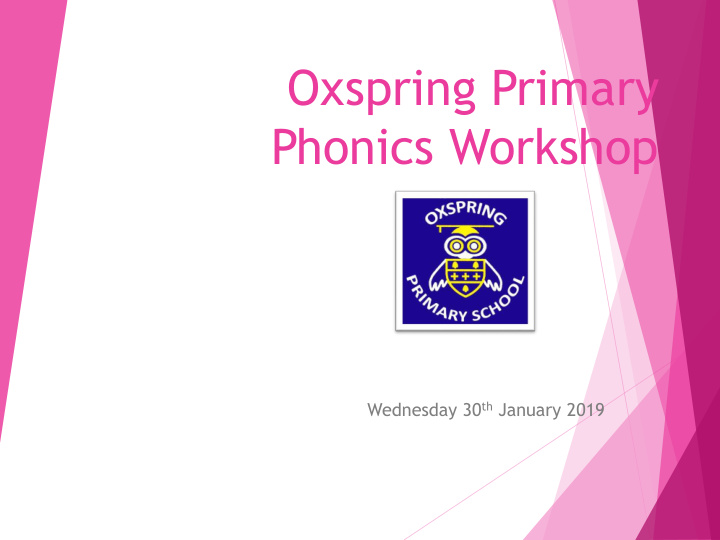



Oxspring Primary Phonics Workshop Wednesday 30 th January 2019
What are the aims of the workshop? To share national expectations in phonics for the Reception Year. To give an overview of how phonics, reading and writing are taught in school. To give ideas of how to support children at home.
What is phonics? Phonics is one method of teaching children how to read and write. It's all about sounds. There are 44 sounds in the English language, which we put together to form words. Some are represented by one letter, like 't', and some by two or more, like 'ck' in duck and 'air' in chair. Some useful words: Phoneme - A phoneme is a single "unit" of sound that has meaning in any language. Grapheme - a grapheme is a ‘symbol’ of a phoneme –it’s a letter or group of letters representing a sound. Digraph : is a two letter grapheme, such as ‘ ch ’, ‘ sh ’, ‘ oa ’ ( two letters making one sound).
Split digraph : the ‘e’ at the end of words works with another letter to make a sound. Think about the difference between hop and hope – both have three sounds (phonemes), but the split digraph in h o p e creates and ‘long o’ sound . Trigraph : a three letter grapheme, where three letters represent one phoneme, as in ear , air , h igh .
Phonics in the EYFS curriculum The Early Learning Goal that the children should achieve by the end of foundation stage states: Reading: Children read and understand simple sentences. They use phonic knowledge to decode regular words and read them aloud accurately. They also read some common irregular words. They demonstrate understanding when talking with others about what they have read.
Writing Children use their phonic knowledge to write words in ways which match their spoken sounds. They also write some irregular common words. They write simple sentences which can be read by themselves and others. Some words are spelt correctly and others are phonetically plausible.
The children in YR, Y1 and Y2 are split into small groups that meet their needs. Begin by introducing the letters – always use the letter sound. The letters are introduced in a particular order so that the children can quickly practise using the sounds to blend and segment.
Sound Pronunciation Guide
How are the phonemes introduced to the children? Sound introduced orally The children practise saying words that begin with the sound Look at the grapheme Handwrite Oral Fred talk Assisted blending – using the pocket chart and magnetic letters. Independent blending
The children read green words (ones that they can decode using their phonics). They also learn tricky red words (common words with uncommon spellings). They also practise spelling words using Fred fingers. They read short texts called Ditties or story books with a partner. The children are assessed every 8 weeks and new groups are formed.
What can I do to support my child at home? Play games that encourage oral blending? e.g. treasure hunt – Can you find a b-oo-k? Action games – Put your foot on the s-t-e-p? Put your hands on your h-i-p-s. Practise reading sounds and words they bring home. Encourage them to use their Fred talk when reading words they can sound out in their reading books and when reading their own books or print in the environment. Encourage your child to chunk longer words when blending. Encourage the children to use their Fred fingers when writing at home. www.oxfordowl.co.uk has ideas for different activities to try at home.
How is reading taught in school? Guided reading – the children read in small groups with other children at a similar reading level. Individual – the children read individually to an adult. Key words – the children learn to read tricky words by sight. Reading for enjoyment – the children enjoy listening to a range of stories and information texts, they join in with key parts of the text and answer questions and discuss what has been read.
How is writing taught in school? Phonic activities inside and outside, writing words and sentences linked to the sounds they are learning in RWI. Shared writing – composing writing as a group. The children help to spell words and remember finger spaces and punctuation. Adult initiated writing - the children use their skills to complete a set task and are usually supported by an adult. Writing through play – the children initiate the writing through their play or are sensitively guided by an adult. Fine motor skills practice and handwriting.
Recommend
More recommend